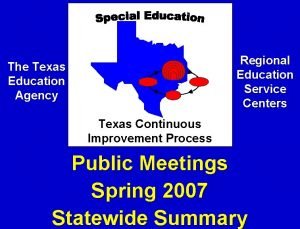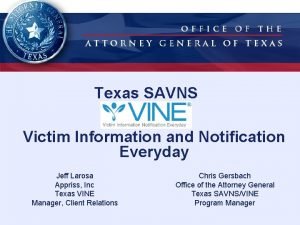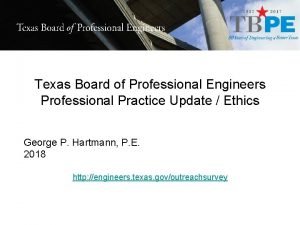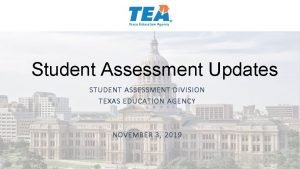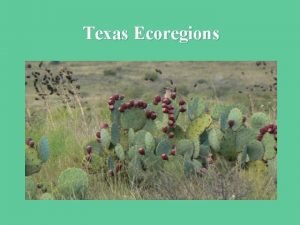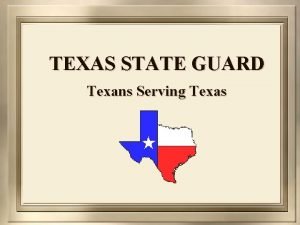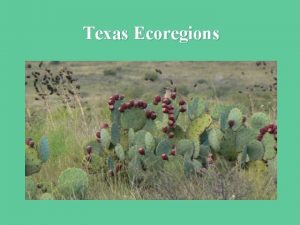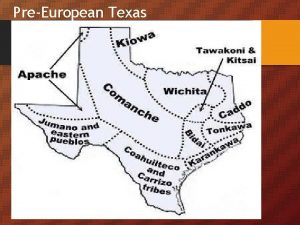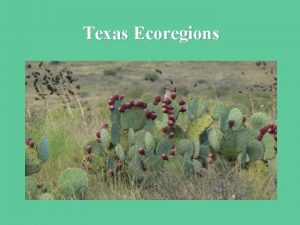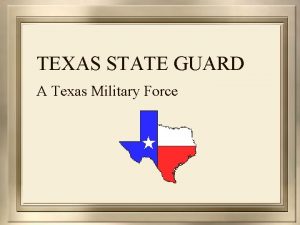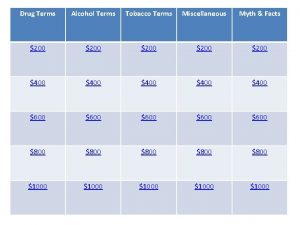Copyright and Terms of Service Copyright Texas Education


































- Slides: 34

Copyright and Terms of Service Copyright © Texas Education Agency, 2011. These materials are copyrighted © and trademarked ™ as the property of the Texas Education Agency (TEA) and may not be reproduced without the express written permission of TEA, except under the following conditions: 1) Texas public school districts, charter schools, and Education Service Centers may reproduce and use copies of the Materials and Related Materials for the districts’ and schools’ educational use without obtaining permission from TEA. 2) Residents of the state of Texas may reproduce and use copies of the Materials and Related Materials for individual personal use only, without obtaining written permission of TEA. 3) Any portion reproduced must be reproduced in its entirety and remain unedited, unaltered and unchanged in any way. 4) No monetary charge can be made for the reproduced materials or any document containing them; however, a reasonable charge to cover only the cost of reproduction and distribution may be charged. Private entities or persons located in Texas that are not Texas public school districts, Texas Education Service Centers, or Texas charter schools or any entity, whether public or private, educational or noneducational, located outside the state of Texas MUST obtain written approval from TEA and will be required to enter into a license agreement that may involve the payment of a licensing fee or a royalty. Contact TEA Copyrights with any questions you may have. Copyright © Texas Education Agency 2011. All rights reserved. Images and other multimedia content used with permission. 1

CRIME SCENE INVESTIGATION Forensic Science Warm-up Who Dunit!!! https: //www. youtube. com/watch? v=ub. NF 9 QNEQLA

Crime Scene Vocabulary CRIME SCENE: Any physical location in which a crime has occurred or is suspected of having occurred. PRIMARY CRIME SCENE: The original location of a crime or accident. SECONDARY CRIME SCENE: An alternate location where additional evidence may be found. SUSPECT: Person thought to be capable of committing a crime. ACCOMPLICE: Person associated with someone suspected of committing a crime. ALIBI: Statement of where a suspect was at the time of a crime. Copyright © Texas Education Agency 2011. All rights reserved. Source: http: //www 3. sc. maricopa. edu/ajs/crime_scene_technician. htm Images and other multimedia content used with permission.

Types of Evidence Testimonial evidence includes oral or written statements given to police as well as court testimony by people who witnessed an event. Physical evidence refers to any material items that would be present at the crime scene, on the victims, or found in a suspect’s possession. Trace evidence refers to physical evidence that is found in small but measurable amounts, such as strands of hair, fibers, or skin cells. What will evidence collected at a scene do for the investigation? • May prove that a crime has been committed • Establish key elements of a crime • Link a suspect with a crime scene or a victim • Establish the identity of a victim or suspect • Corroborate verbal witness testimony • Exonerate the innocent. • Give detectives leads to work with in the case Copyright © Texas Education Agency 2011. All rights reserved. Source: http: //www 3. sc. maricopa. edu/ajs/crime_scene_technician. htm Images and other multimedia content used with permission.

Crime Scene Personnel POLICE OFFICERS are typically the first to arrive at a crime scene. They are responsible for securing the scene so no evidence is destroyed and detaining persons of interest in the crime. The CSI UNIT documents the crime scene in detail and collects any physical evidence. The DISTRICT ATTORNEY is often present to help determine if any search warrants are required to proceed and obtains those warrants from a judge. The MEDICAL EXAMINER (if a homicide) may or may not be present to determine a preliminary cause of death. SPECIALISTS (forensic entomologists, anthropologists, or psychologists) may be called in if the evidence requires expert analysis. DETECTIVES interview witnesses and consult with the CSI unit. They investigate the crime by following leads provided by witnesses and physical evidence. Source: http: //science. howstuffworks. com/csi. htm

Crime Scene Protocol Step 1: Interview The first step in investigating a crime scene is to interview the first officer at the scene or the victim to determine what allegedly happened, what crime took place, and how was the crime committed. This information may not be factual information but it will give the investigators a place to start. Step 2: Examine The second step in the investigation of a crime scene, which will help identify possible evidence, identify the point of entry and point of exit, and outline the general layout of the crime scene. Step 3: Document The third step in the protocol involves creating a pictorial record of the scene as well as a rough sketch to demonstrate the layout of the crime scene and to identify the exact position of the deceased victim or other evidence within the crime scene. Step 4: Process This is the last step in the protocol. The crime scene technician will process the crime scene for evidence, both physical and testimonial evidence. It is the crime scene technicians responsibility to identify, evaluate and collect physical evidence from the crime scene for further analysis by a crime laboratory. Copyright © Texas Education Agency 2011. All rights reserved. Adapted from http: //www. feinc. net/cs-proc. htm Images and other multimedia content used with permission.

Investigating the Evidence Drug Chemistry – Determines the presence of controlled substances and the identification of marijuana Trace Chemistry - Identification and comparison of materials from fires, explosions, paints, and glass. Microscopy – Microscopic identification and comparison of evidence, such as hairs, fibers, woods, soils, building materials, insulation and other materials. Biology/DNA – Analysis of body fluids and dried stains such as blood, semen, and saliva. Toxicology – Tests body fluids and tissues to determine the presence of drugs and poisons. Latent Prints - Identification and comparison of fingerprints or other hidden impressions from sources like feet, shoes, ears, lips or the tread on vehicle tires. Ballistics (Firearms) – Study of bullets and ammunition through the comparison of fired bullets, cartridges, guns, and gunpowder patterns on people and objects. Toolmarks – Examines marks left by tools on objects at a crime scene or on a victim, such as a hammer used to break a door or a screwdriver used to pick a lock. Questioned Documents - Examination of documents to compare handwriting, ink, paper, writing instruments, printers, and other characteristics that would help to identify its origin. Source: http: //www. isp. state. il. us/forensics/

What evidence would you collect? Mock Crime Scene: http: //www. masss. gov Copyright © Texas Education Agency 2011. All rights reserved. Images and other multimedia content used with permission.

Process a Crime Scene � Isolate and secure the scene � Document the scene � Search for evidence � � Collect and package the evidence while maintaining the chain of custody Submit the evidence for analysis Copyright © Texas Education Agency 2011. All rights reserved. Images and other multimedia content used with permission. 9

First Officer on the Scene A – Assess the crime scene and assist the injured D – Detain the witness(es) A – Arrest the perpetrator P – Protect the crime scene T – Take notes Copyright © Texas Education Agency 2011. All rights reserved. Images and other multimedia content used with permission. 10

Secure the Crime Scene 1) 2) 3) Look for signs of life Cordon off the scene (only allow authorized personnel in) Bodies should be certified as “dead” by a medical examiner (ME) before being moved Copyright © Texas Education Agency 2011. All rights reserved. Images and other multimedia content used with permission. 11

Survey the Crime Scene � � � A walkthrough is performed by the crime scene investigator, the first officer, and sometimes the lead detective Record initial observations of who, what, where, when, and how Make a plan of action Copyright © Texas Education Agency 2011. All rights reserved. Images and other multimedia content used with permission. 12

Document the Crime Scene � Record the crime scene and potential evidence with �Notes �Photography �Sketches �Videography Copyright © Texas Education Agency 2011. All rights reserved. Images and other multimedia content used with permission. 13

Notes � Record the following while at the crime scene (details are the key): � Date � Time � Description of the location, weather, and environmental conditions � Description of the crime � Location of the evidence relative to other key points � Names of all people involved � Any other relevant information Copyright © Texas Education Agency 2011. All rights reserved. Images and other multimedia content used with permission. 14

Photography � � � Nothing should be moved until photographed Take photos of the scene and the surroundings Photograph entrances and exits Take wide and close-up photos Use various angles for each piece of evidence Use a ruler to show size Copyright © Texas Education Agency 2011. All rights reserved. Images and other multimedia content used with permission. 15

Sketches � � Draw a rough sketch at the scene (reconstruct it better later) Include �Date, time, and location �Scale �Recovered items �Important features �Accurate distance measurements of objects (from two fixed points) �A legend for description of items �A compass designating north �Names of investigators, victims, and suspects 16 Copyright © Texas Education Agency 2011. All rights reserved. Images and other multimedia content used with permission.

Example: Final Sketch Copyright © Texas Education Agency 2011. All rights reserved. Images and other multimedia content used with permission. 17

Videography � � � Narrate the video Be objective Record from different perspectives Copyright © Texas Education Agency 2011. All rights reserved. Images and other multimedia content used with permission. 18

Measuring Techniques � Triangulation �For each piece of evidence being recorded, use two permanent objects as reference points that are not likely to be moved �The two reference points and the piece of evidence form a triangle, hence the term triangulation �Whatever object you are measuring to or from, use the same spot on the object every time Copyright © Texas Education Agency 2011. All rights reserved. Images and other multimedia content used with permission. 19

Measuring Techniques (continued) � Rectangular Coordinates – Baseline � The simplest form of the rectangular coordinate system � Using a straight line between two known points, items are measured along the line and then measured perpendicular to the line � Inside or outside of a house, this line can be a straight wall � Outdoor scenes can use a string or long measuring tape as the reference or baseline Copyright © Texas Education Agency 2011. All rights reserved. Images and other multimedia content used with permission. 20

Measuring Techniques (continued) � Rectangular Coordinates – Grid � Measure the distance of items from two perpendicular baselines � This technique is particularly appropriate in a room with perpendicular walls or outdoors with perpendicular streets Copyright © Texas Education Agency 2011. All rights reserved. Images and other multimedia content used with permission. 21

Measuring Techniques (continued) � Polar Coordinates �Measure both the distance and the direction (angle) an object is from a known reference point �For example, 40 feet from the edge of the house and 15 degrees east of north Copyright © Texas Education Agency 2011. All rights reserved. Images and other multimedia content used with permission. 22

Search the Crime Scene � When searching a crime scene, wear the following, if available, to minimize contamination � Disposable gloves � Masks � Coveralls with a hood � Slippers Copyright © Texas Education Agency 2011. All rights reserved. Images and other multimedia content used with permission. 23

Search Patterns � � � Depend on the size and the location of the crime scene and the number of investigators available Stick to one pattern and one supervisor Better to collect everything and not need it than fail to collect something and need it later Copyright © Texas Education Agency 2011. All rights reserved. Images and other multimedia content used with permission. 24

Search Patterns (continued) � � Spiral – may move inward or outward; best used where there are no physical barriers Grid – basically a double-line search; effective, but time-consuming Line (Strip) – best in large, outdoor scenes Zone (Quadrant) – most effective in houses or buildings; teams are assigned small zones for searching Copyright © Texas Education Agency 2011. All rights reserved. Images and other multimedia content used with permission. 25

Search Patterns (continued) Spiral Strip or Line Grid Quadrant or Zone Copyright © Texas Education Agency 2011. All rights reserved. Images and other multimedia content used with permission. 26

Collect & Package Evidence � � � Physical evidence must be packaged and collected before time and weather can alter it Physical evidence – any object that can establish that a crime has been committed or links a crime and the victim or suspect The Golden Hour – the window of opportunity to collect time-sensitive information or evidence Copyright © Texas Education Agency 2011. All rights reserved. Images and other multimedia content used with permission. 27

Collect & Package Evidence (continued) � � Each item must be placed in a separate container, and sealed and labeled The most fragile evidence is collected and packaged first � Different types of evidence require specific or special collection and packaging techniques � The body is the property of the coroner or medical examiner; collection of evidence on the body is done by that department Copyright © Texas Education Agency 2011. All rights reserved. Images and other multimedia content used with permission. 28

Collect & Package Evidence (continued) � � � Containers such as vials, envelopes, plastic bags, paper bags, canisters, and cardboard boxes are good packaging devices Most items should be placed in a primary container and then in a secondary container Trace evidence may be placed on a piece of paper which is then folded in a “druggist fold” and placed in a secondary container Copyright © Texas Education Agency 2011. All rights reserved. Images and other multimedia content used with permission. 29

druggist fold (get paper) � https: //www. youtube. com/watch? v=j 1 NMJUu. R ZMU � Practice using a piece of notebook paper. Copyright © Texas Education Agency 2011. All rights reserved. Images and other multimedia content used with permission. 30

Collect & Package Evidence (continued) � � Containers should be sealed with tamper proof tape, and dated and initialed Each package should contain � Date, time, and location � Case number � Agency and collector’s name � Victim’s name(s) � Description of contents � Never package two items from two different sources or locations Copyright © Texas Education Agency 2011. All rights reserved. Images and other multimedia content used with permission. 31

Chain of Custody � � � There must be a written record of all people who have had possession of an item of evidence, beginning at the time of collection Every person who handled or examined the evidence must be accounted for Chain of Custody should include � Date and time of transfer � Location of transfer � To/From names � Purpose of the transfer Copyright © Texas Education Agency 2011. All rights reserved. Images and other multimedia content used with permission. 32

National Databases � � Crime Scene Investigators can submit evidence for analysis to several national databases based on the type of evidence Examples include � Automated Fingerprint Identification System (AFIS) � Integrated Automated Fingerprint Identification System (IAFIS) � Combined DNA Index System (CODIS) � Integrated Ballistics Identification System (IBIS) � International Forensic Automotive Paint Data Query (PDQ) Copyright © Texas Education Agency 2011. All rights reserved. Images and other multimedia content used with permission. 33

Resources � � 0135158494, Saferstein, Richard. Forensic Science: An Introduction. New Jersey: Pearson Prentice Hall, 2008. 0757518257, Ball-Deslich, Barbara and John Funkhouser. Forensic Science for High School. 2 nd Edition. Kenall/Hunt, 2009. Copyright © Texas Education Agency 2011. All rights reserved. Images and other multimedia content used with permission. 34
 Texas regional education service centers
Texas regional education service centers Polynomial degrees and terms
Polynomial degrees and terms Like terms
Like terms Civil service modernised terms and conditions
Civil service modernised terms and conditions Civil service modernised terms and conditions
Civil service modernised terms and conditions 2017 pearson education ltd
2017 pearson education ltd Copyright pearson education inc
Copyright pearson education inc Copyright 2010 pearson education inc
Copyright 2010 pearson education inc Copyright 2009
Copyright 2009 2018 pearson education inc
2018 pearson education inc Copyright 2014 pearson education inc
Copyright 2014 pearson education inc Copyright 2010 pearson education inc
Copyright 2010 pearson education inc Copyright 2010 pearson education inc
Copyright 2010 pearson education inc Copyright by pearson education inc. answers
Copyright by pearson education inc. answers 2008 pearson education inc
2008 pearson education inc Copyright 2009 pearson education inc
Copyright 2009 pearson education inc Copyright pearson education inc
Copyright pearson education inc Copyright 2010 pearson education inc
Copyright 2010 pearson education inc Copyright 2010 pearson education inc
Copyright 2010 pearson education inc Copyright 2010 pearson education inc
Copyright 2010 pearson education inc 2010 pearson education inc
2010 pearson education inc Copyright 2010 pearson education inc
Copyright 2010 pearson education inc Composition copyright example
Composition copyright example Pearson education inc all rights reserved
Pearson education inc all rights reserved Copyright 2009 pearson education inc
Copyright 2009 pearson education inc Copyright 2009 pearson education inc
Copyright 2009 pearson education inc Copyright 2009 pearson education inc
Copyright 2009 pearson education inc Copyright 2009 pearson education inc
Copyright 2009 pearson education inc Copyright pearson education inc
Copyright pearson education inc Texas statewide vine service
Texas statewide vine service Board of professional engineers texas
Board of professional engineers texas Dccr texas education agency
Dccr texas education agency Special education language acquisition tea
Special education language acquisition tea Texas education agency jobs
Texas education agency jobs Texas women in higher education
Texas women in higher education
